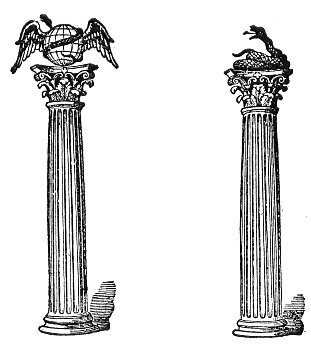We read in Anaxagoras, that Orpheus said, that the water, and the vessel that produced it, were the primitive principles of things, and together gave existence to an animated being, which was a serpent, with two heads, one of a lion and the other of a bull, between which was the figure of a God whose name was Hercules or Kronos: that from Hercules came the egg of the world, which produced Heaven and earth, by dividing itself into two hemispheres: and that the God Phanes, which issued from that egg, was in the shape of a serpent.
The Egyptian Goddess Ken, represented standing naked on a lion, held two serpents in her hand. She is the same as the Astarte or Ashtaroth of the Assyrians. Hera, worshipped in the Great Temple at Babylon, held in her right hand a serpent by the head; and near Khea, also worshipped there, were two large silver serpents.
In a sculpture from Kouyunjik, two serpents attached to poles are near a fire-altar, at which two eunuchs are standing. Upon it is the sacred fire, and a bearded figure leads a wild goat to the sacrifice.
p. 496
The serpent of the Temple of Epidaurus was sacred to Æsculapius, the God of Medicine, and 462 years after the building of the city, was taken to Rome after a pestilence.
The Phœnicians represented the God Nomu (Kneph or Amun-Kneph) by a serpent. In Egypt, a Sun supported by two asps was the emblem of Horhat the good genius; and the serpent with the winged globe was placed over the doors and windows of the Temples as a tutelary God. Antipater of Sidon calls Amun “the renowned Serpent,” and the Cerastes is often found embalmed in the Thebaid.
On ancient Tyrian coins and Indian medals, a serpent was represented, coiled round the trunk of a tree. Python, the Serpent Deity, was esteemed oracular; and the tripod at Delphi was a triple-headed serpent of gold.
The portals of all the Egyptian Temples are decorated with the hierogram of the Circle and the Serpent. It is also found upon the Temple of Naki-Rustan in Persia; on the triumphal arch at Pechin, in China; over the gates of the great Temple of Chaundi Teeva, in Java; upon the walls of Athens; and in the Temple of Minerva at Tegea. The Mexican hierogram was formed by the intersecting of two great Serpents, which described the circle with their bodies, and had each a human head in its mouth.
All the Buddhists crosses in Ireland had serpents carved upon them. Wreaths of snakes are on the columns of the ancient Hindu Temple at Burwah-Sangor.
Among the Egyptians, it was a symbol of Divine Wisdom, when extended at length; and, with its tail in its mouth, of Eternity.
In the ritual of Zoroaster, the Serpent was a symbol of the Universe. In China, the ring between two Serpents was the symbol of the world governed by the power and wisdom of the Creator. The Bacchanals carried serpents in their hands or round their heads.
The Serpent entwined round an Egg, was a symbol common to the Indians, the Egyptians, and the Druids. It referred to the creation of the Universe. A Serpent with an egg in his mouth was a symbol of the Universe containing within itself the germ of all things that the Sun develops.
The property possessed by the Serpent, of casting its skin, and apparently renewing its youth, made it an emblem of eternity and immortality. The Syrian women still employ it as a charm against
p. 497
barrenness, as did the devotees of Mithras and Saba-Zeus. The Earth-born civilizers of the early world, Fohi, Cecrops, and Erechtheus, were half-man, half-serpent. The snake was the guardian of the Athenian Acropolis. NAKHUSTAN, the brazen serpent of the wilderness, became naturalized among the Hebrews as a token of healing power. “Be ye,” said Christ, “wise as serpents, and harmless as doves.”
The Serpent was as often a symbol of malevolence and enmity. It appears among the emblems of Siva-Roudra, the power of desolation and death: it is the bane of Aëpytus, Idom, Archemorus, and Philoctetes: it gnaws the roots of the tree of life in the Eddas, and bites the heel of unfortunate Eurydice. In Hebrew writers it is generally a type of evil; and is particularly so in the Indian and Persian Mythologies. When the Sea is churned by Mount Mandar rotating within the coils of the Cosmical Serpent Vasouki, to produce the Amrita or water of immortality, the serpent vomits a hideous poison, which spreads through and infects the Universe, but which Vishnu renders harmless by swallowing it. Ahriman in serpent-form invades the realm of Ormuzd; and the Bull, emblem of life, is wounded by him and dies. It was therefore a religious obligation with every devout follower of Zoroaster to exterminate reptiles, and other impure animals, especially serpents. The moral and astronomical significance of the Serpent were connected. It became a maxim of the Zend-Avesta, that Ahriman, the Principle of Evil, made the Great Serpent of Winter, who assaulted the creation of Ormuzd.

Moe is the founder of GnosticWarrior.com. He is a father, husband, author, martial arts black belt, and an expert in Gnosticism, the occult, and esotericism.






